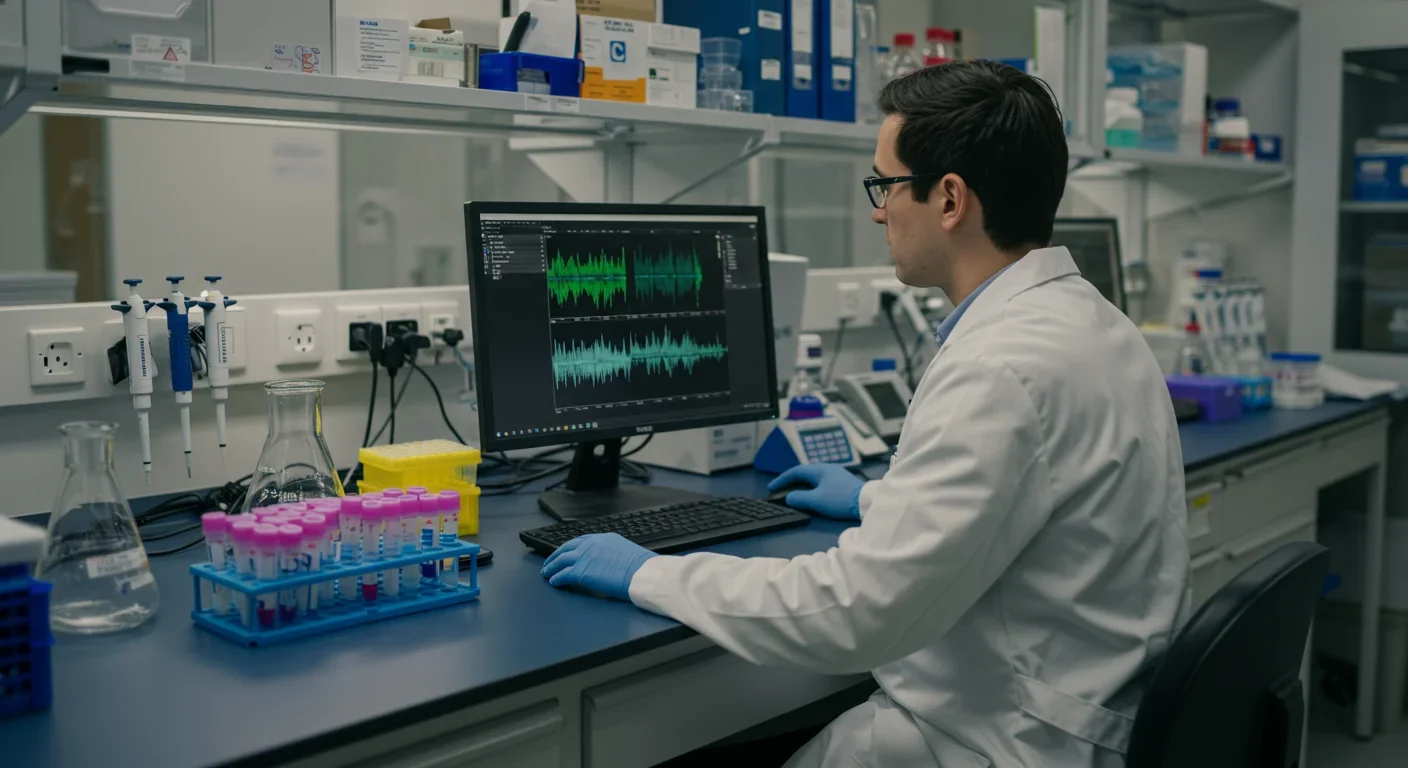Epigenetic Clocks Predict Disease 30 Years Early

TL;DR: Bacteria exchange genes horizontally at astonishing speeds, spreading antibiotic resistance globally within months through plasmids and other mechanisms, fundamentally challenging our understanding of evolution and demanding urgent new strategies in medicine and public health.

By 2030, scientists predict that more people could die from antibiotic-resistant infections than from cancer. The culprit? Not slow evolution or random mutation, but something far more insidious—bacteria swapping genetic code like kids trading cards on a playground. While you're reading this sentence, millions of microbes around and inside you are exchanging DNA in real time, rewiring their genomes to survive antibiotics, evade immune systems, and colonize new hosts. This isn't science fiction. It's horizontal gene transfer (HGT), and it's rewriting the rules of evolution faster than Darwin ever imagined.
For decades, we thought evolution was a patient sculptor, slowly chiseling species over millions of years through random mutations and natural selection. Then researchers discovered something shocking: bacteria don't wait. They steal, share, and incorporate genetic material from completely unrelated organisms—sometimes within hours. Recent studies have documented real-time DNA transfer in hospital settings, agricultural environments, and even the human gut, revealing a biological internet of genetic information that operates 24/7.
In 2015, scientists identified the first plasmid-mediated colistin resistance gene, mcr-1, in China. Within months, this single gene had spread to 31 countries across five continents on 13 different plasmid backgrounds—genetic vehicles that jump between bacterial species with alarming ease. It wasn't gradual adaptation. It was a genetic pandemic, and we watched it unfold in real time.
What makes HGT so revolutionary isn't just its speed but its promiscuity. Unlike sexual reproduction, which restricts gene flow to closely related organisms, HGT allows bacteria to acquire traits from distant relatives—even different kingdoms of life. It's like a human suddenly growing gills because they shook hands with a fish.
Think of HGT as biological file-sharing with three different upload methods: conjugation, transformation, and transduction. Each operates through distinct mechanisms but achieves the same goal—moving DNA from donor to recipient without waiting for reproduction.
Conjugation is the most direct route. Donor bacteria extend a sex pilus—a microscopic bridge—to a recipient cell, forming physical contact that allows plasmids (circular DNA molecules) to flow from one organism to another. These plasmids often carry multiple genes bundled together, including antibiotic resistance markers, virulence factors, and metabolic innovations. In gram-negative bacteria like E. coli, this process is so efficient that a single resistant bacterium can convert an entire population within days.
Transformation takes a different approach—scavenging. When bacteria die, they release DNA into the environment. Certain species have evolved "competence"—the ability to absorb free-floating DNA fragments and integrate them into their own genomes. Naturally competent bacteria like Haemophilus and Streptococcus do this routinely, but scientists have also learned to induce competence artificially. Exposing E. coli to calcium chloride, for instance, opens pores in the cell membrane, creating entry points for foreign DNA. This lab technique has become foundational to genetic engineering, allowing researchers to insert human insulin genes into bacteria to produce medicine.
Transduction co-opts viruses as unwitting couriers. Bacteriophages—viruses that infect bacteria—sometimes accidentally package bacterial DNA instead of their own genetic material. When these mislabeled phages infect a new host, they inject bacterial genes rather than viral instructions. While transduction is limited by the narrow host range of most phages, it can transfer large genetic segments in a single event, making it a potent evolutionary tool in specialized environments.
The discovery of HGT upended 20th-century biology. Before the 1950s, scientists assumed that genetic inheritance flowed strictly from parent to offspring—a vertical, tree-like process. Then Joshua Lederberg demonstrated bacterial conjugation, proving that microbes exchange genes horizontally across lineages. At first, this seemed like a curious bacterial quirk, irrelevant to higher organisms and human health.
That assumption proved catastrophic. In 1959, Japanese researchers identified plasmids carrying multiple antibiotic resistance genes in Shigella, the bacterium causing dysentery. These "R-plasmids" could transfer between unrelated bacterial species, turning previously treatable infections into medical emergencies. By the 1970s, hospitals worldwide faced outbreaks of multidrug-resistant pathogens—a direct consequence of HGT accelerated by antibiotic overuse.
The lesson from history is clear: human activity doesn't just select for resistance; it turbocharges the genetic networks that spread it. Agricultural antibiotics, hospital wastewater, and even household cleaning products create environments where resistance genes flow freely between species, habitats, and continents. Every misuse of antibiotics doesn't just breed resistant bacteria—it funds a genetic lottery where winning tickets get copied and distributed globally.

Walk into any intensive care unit, and you'll encounter the legacy of HGT: carbapenem-resistant Enterobacteriaceae (CRE), vancomycin-resistant Enterococcus (VRE), and methicillin-resistant Staphylococcus aureus (MRSA). These so-called nightmare bacteria kill thousands annually, and their resistance arsenal comes almost entirely from horizontal gene transfer.
Consider Acinetobacter baumannii, a once-obscure soil bacterium that now haunts hospitals worldwide. Recent surveillance data show 93.3% resistance to meropenem, a last-resort carbapenem antibiotic. How did a harmless environmental microbe become a superbug? HGT. A. baumannii acts like a genetic sponge, absorbing resistance genes from plasmids circulating through hospital ecosystems—sink drains, ventilators, and even healthcare workers' hands.
Plasmids don't operate alone. They're nestled inside transposons—mobile genetic elements that can hop between chromosomes and plasmids, creating "mosaic" structures packed with resistance genes. These mosaic plasmids exhibit significantly higher proportions of transposase enzymes and antibiotic resistance genes, making them especially potent vectors of multidrug resistance in clinical genera like Klebsiella and Salmonella.
What's truly frightening is the speed. Hospital outbreak investigations have documented carbapenem resistance genes spreading from environmental reservoirs like sink drains to patients within weeks. A single contaminated water source can seed an entire ward with resistant bacteria, transmitted not through direct contact but through plasmid-mediated HGT.
While bacteria dominate HGT research, the phenomenon extends far beyond microbial kingdoms. Recent studies have identified horizontally transferred genes in insects, plants, fungi, and even animals. Bdelloid rotifers—microscopic freshwater invertebrates—have acquired nearly 10% of their genome from bacteria, fungi, and plants through HGT, gaining novel metabolic capabilities that help them survive extreme dehydration.
In cancer biology, researchers are uncovering unsettling parallels. Tumor cells don't just accumulate mutations—they can acquire DNA from surrounding cells through mechanisms resembling bacterial transformation. Cell-free chromatin particles released by dying cells can be absorbed by cancer cells, potentially transferring oncogenes or drug resistance markers. While this process remains poorly understood, it suggests that HGT-like mechanisms may accelerate cancer evolution and complicate treatment.
Viruses, of course, have always practiced HGT. Retroviruses like HIV integrate their genetic material into host chromosomes, sometimes picking up human genes that get transferred to the next infected cell. Over evolutionary time, ancient viral infections have littered human genomes with remnants of viral DNA—roughly 8% of our genome consists of endogenous retroviruses, fossil sequences from infections millions of years ago. Some of these viral sequences now perform essential functions, including placental development, illustrating how HGT can drive not just disease but innovation.
If HGT sounds dangerous, that's because it is—but it's also one of biotechnology's most powerful tools. The same mechanisms that spread antibiotic resistance also enable synthetic biology, vaccine development, and gene therapy.
Modern genetic engineering relies almost entirely on transformation and transduction. Scientists routinely use plasmids to insert human genes into bacteria, producing insulin, growth hormones, and industrial enzymes at scale. CRISPR-Cas9, the revolutionary gene-editing system, originated as a bacterial defense against viral HGT—bacteria evolved molecular scissors to cut and remember viral DNA, preventing reinfection. Now we've repurposed that system to edit genomes across species, from crops to humans.
But every biotechnological advance carries risk. Engineered plasmids released into the environment could theoretically transfer to wild bacteria, spreading novel traits into ecosystems with unpredictable consequences. While containment protocols minimize this risk, the history of HGT suggests that gene flow is inevitable over long timescales. The question isn't whether engineered genes will escape—it's when, and whether we'll be prepared.
Ethical concerns loom large. Should we engineer bacteria to outcompete antibiotic-resistant strains, knowing that the resistance-breaking genes might themselves spread horizontally? Should we use HGT-based therapies to treat genetic diseases, accepting that introduced DNA could theoretically integrate into unintended cells? These aren't hypothetical dilemmas—they're active research frontiers where the pace of innovation outstrips regulatory frameworks.

HGT doesn't respect boundaries—geographic, ecological, or regulatory. Recent genomic surveillance has revealed that antibiotic resistance genes circulate through interconnected reservoirs spanning agriculture, wastewater, wildlife, and human populations. This is the One Health reality: what happens on a pig farm in China can show up in a hospital in Cleveland within months.
Broad-host-range plasmids like IncP-1 serve as genetic shuttles, moving between diverse bacterial species across environments. These plasmids have been isolated from produce, soil, manure, wastewater, and river systems, demonstrating that ecological interfaces—where different habitats meet—act as HGT hotspots. A wastewater treatment plant receiving agricultural runoff and hospital effluent becomes a genetic mixing bowl, where bacteria from disparate sources conjugate and exchange resistance genes.
Global trade accelerates this process. Contaminated food products, imported livestock, and international travelers all carry microbial hitchhikers bearing resistance plasmids. The mcr-1 colistin resistance gene, first detected in Chinese poultry, reached Europe and North America within a year, carried by food products and human travelers. No border control can stop plasmids.
International cooperation is essential but frustratingly slow. While organizations like WHO and FAO promote antimicrobial stewardship, enforcement varies wildly. Countries with weak regulation continue using antibiotics as agricultural growth promoters, creating reservoirs of resistance that spill into global circulation. Until every nation adopts stringent controls, HGT will continue to undermine even the best local efforts.
The question isn't whether HGT will continue reshaping microbial genomes—it's whether we'll adapt our strategies fast enough to stay ahead. Traditional antibiotic development can't keep pace with horizontal gene transfer; bacteria acquire resistance faster than pharmaceutical companies can design new drugs.
New approaches are emerging. Phage therapy—using bacteriophages to kill resistant bacteria—exploits the same viral machinery that drives transduction but turns it against pathogens. Early trials show promise, though scaling phage therapy requires overcoming regulatory hurdles designed for chemical drugs, not living organisms.
Probiotics and microbiome engineering offer another avenue. By cultivating diverse, competitive microbial communities in our guts, farms, and hospitals, we might reduce the ecological niches where resistant bacteria thrive. Some researchers are even designing probiotic plasmids that outcompete resistance plasmids, using HGT against itself.
Surveillance is critical. Genomic monitoring can track resistance genes as they move through environments, identifying transmission routes before clinical outbreaks occur. Countries like Denmark and the Netherlands have implemented integrated surveillance systems linking agricultural, environmental, and clinical data, enabling early intervention. Expanding this model globally requires investment, data sharing, and political will—resources currently in short supply.
Education matters too. Patients who understand HGT are more likely to complete antibiotic courses, reducing selection pressure for resistance. Farmers who recognize that agricultural antibiotics fuel resistance plasmids may adopt alternatives. Healthcare workers who grasp how easily plasmids spread will practice stricter hygiene. HGT literacy isn't just academic—it's a public health imperative.
Horizontal gene transfer has transformed evolution from a slow burn into a wildfire. Where Darwin saw gradual change over millennia, we now witness genetic revolutions unfolding in real time—resistance genes circling the globe in months, bacterial genomes rewiring overnight, and ecosystems adapting to human pressures faster than policy can respond.
The implications extend beyond medicine. HGT challenges our understanding of species boundaries, inheritance, and biological identity. If organisms routinely swap genetic code across kingdoms, is the "tree of life" really a network? If cancer cells practice transformation, should we treat tumors as evolving ecosystems rather than rogue clones? If ancient viral HGT built our placentas, how much of "human" DNA is truly ours?
These aren't just philosophical puzzles—they're practical questions that will shape biotechnology, medicine, and ecology for generations. As we engineer organisms, design therapies, and steward ecosystems, we're operating in a world where genes flow horizontally as readily as vertically. The bacteria have been practicing this for billions of years. We're just starting to catch up.
The genetic internet is always on, always transferring data, always adapting. The only question is whether we'll learn to navigate it—or get swept away in the current.

Recent breakthroughs in fusion technology—including 351,000-gauss magnetic fields, AI-driven plasma diagnostics, and net energy gain at the National Ignition Facility—are transforming fusion propulsion from science fiction to engineering frontier. Scientists now have a realistic pathway to accelerate spacecraft to 10% of light speed, enabling a 43-year journey to Alpha Centauri. While challenges remain in miniaturization, neutron management, and sustained operation, the physics barriers have ...

Epigenetic clocks measure DNA methylation patterns to calculate biological age, which predicts disease risk up to 30 years before symptoms appear. Landmark studies show that accelerated epigenetic aging forecasts cardiovascular disease, diabetes, and neurodegeneration with remarkable accuracy. Lifestyle interventions—Mediterranean diet, structured exercise, quality sleep, stress management—can measurably reverse biological aging, reducing epigenetic age by 1-2 years within months. Commercial ...

Data centers consumed 415 terawatt-hours of electricity in 2024 and will nearly double that by 2030, driven by AI's insatiable energy appetite. Despite tech giants' renewable pledges, actual emissions are up to 662% higher than reported due to accounting loopholes. A digital pollution tax—similar to Europe's carbon border tariff—could finally force the industry to invest in efficiency technologies like liquid cooling, waste heat recovery, and time-matched renewable power, transforming volunta...

Humans are hardwired to see invisible agents—gods, ghosts, conspiracies—thanks to the Hyperactive Agency Detection Device (HADD), an evolutionary survival mechanism that favored false alarms over fatal misses. This cognitive bias, rooted in brain regions like the temporoparietal junction and medial prefrontal cortex, generates religious beliefs, animistic worldviews, and conspiracy theories across all cultures. Understanding HADD doesn't eliminate belief, but it helps us recognize when our pa...

The bombardier beetle has perfected a chemical defense system that human engineers are still trying to replicate: a two-chamber micro-combustion engine that mixes hydroquinone and hydrogen peroxide to create explosive 100°C sprays at up to 500 pulses per second, aimed with 270-degree precision. This tiny insect's biochemical marvel is inspiring revolutionary technologies in aerospace propulsion, pharmaceutical delivery, and fire suppression. By 2030, beetle-inspired systems could position sat...

The U.S. faces a catastrophic care worker shortage driven by poverty-level wages, overwhelming burnout, and systemic undervaluation. With 99% of nursing homes hiring and 9.7 million openings projected by 2034, the crisis threatens patient safety, family stability, and economic productivity. Evidence-based solutions—wage reforms, streamlined training, technology integration, and policy enforcement—exist and work, but require sustained political will and cultural recognition that caregiving is ...

Every major AI model was trained on copyrighted text scraped without permission, triggering billion-dollar lawsuits and forcing a reckoning between innovation and creator rights. The future depends on finding balance between transformative AI development and fair compensation for the people whose work fuels it.